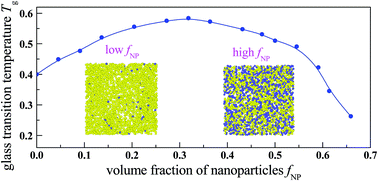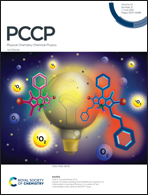A novel shift in the glass transition temperature of polymer nanocomposites: a molecular dynamics simulation study†
Abstract
The effect of the loading of nanoparticles on the glass transition temperature, Tg, of polymer nanocomposites is studied by using molecular dynamics simulations. Tg is estimated from the variation of system volume with temperature and the temperature-dependent diffusion of the polymer described by the Vogel–Fulcher–Tammann law. The estimated values of Tg from the two methods are consistent with each other. Results show that Tg can be regulated by changing the volume fraction of nanoparticles, fNP. A novel shift in Tg is observed, that is, Tg increases with fNP at fNP <  , while it decreases with increasing fNP at fNP >
, while it decreases with increasing fNP at fNP >  . The basic mechanism behind the novel shift in Tg is the competition between the attraction of nanoparticles towards polymer chains and the fast diffusion of nanoparticles. The increase in Tg at low fNP is due to the attraction of nanoparticles, whereas the decrease in Tg at high fNP is attributed to the fast diffusion of nanoparticles. The diffusion of the polymer above Tg is also investigated. The diffusion of the polymer decreases with increasing fNP below
. The basic mechanism behind the novel shift in Tg is the competition between the attraction of nanoparticles towards polymer chains and the fast diffusion of nanoparticles. The increase in Tg at low fNP is due to the attraction of nanoparticles, whereas the decrease in Tg at high fNP is attributed to the fast diffusion of nanoparticles. The diffusion of the polymer above Tg is also investigated. The diffusion of the polymer decreases with increasing fNP below  and increases with fNP above
and increases with fNP above  , in agreement with the variation of Tg.
, in agreement with the variation of Tg.



 Please wait while we load your content...
Please wait while we load your content...